Wojciech Stokowiec
Gemma: Open Models Based on Gemini Research and Technology
Mar 13, 2024



Abstract:This work introduces Gemma, a family of lightweight, state-of-the art open models built from the research and technology used to create Gemini models. Gemma models demonstrate strong performance across academic benchmarks for language understanding, reasoning, and safety. We release two sizes of models (2 billion and 7 billion parameters), and provide both pretrained and fine-tuned checkpoints. Gemma outperforms similarly sized open models on 11 out of 18 text-based tasks, and we present comprehensive evaluations of safety and responsibility aspects of the models, alongside a detailed description of model development. We believe the responsible release of LLMs is critical for improving the safety of frontier models, and for enabling the next wave of LLM innovations.
Gemini 1.5: Unlocking multimodal understanding across millions of tokens of context
Mar 08, 2024Abstract:In this report, we present the latest model of the Gemini family, Gemini 1.5 Pro, a highly compute-efficient multimodal mixture-of-experts model capable of recalling and reasoning over fine-grained information from millions of tokens of context, including multiple long documents and hours of video and audio. Gemini 1.5 Pro achieves near-perfect recall on long-context retrieval tasks across modalities, improves the state-of-the-art in long-document QA, long-video QA and long-context ASR, and matches or surpasses Gemini 1.0 Ultra's state-of-the-art performance across a broad set of benchmarks. Studying the limits of Gemini 1.5 Pro's long-context ability, we find continued improvement in next-token prediction and near-perfect retrieval (>99%) up to at least 10M tokens, a generational leap over existing models such as Claude 2.1 (200k) and GPT-4 Turbo (128k). Finally, we highlight surprising new capabilities of large language models at the frontier; when given a grammar manual for Kalamang, a language with fewer than 200 speakers worldwide, the model learns to translate English to Kalamang at a similar level to a person who learned from the same content.
Gemini: A Family of Highly Capable Multimodal Models
Dec 19, 2023Abstract:This report introduces a new family of multimodal models, Gemini, that exhibit remarkable capabilities across image, audio, video, and text understanding. The Gemini family consists of Ultra, Pro, and Nano sizes, suitable for applications ranging from complex reasoning tasks to on-device memory-constrained use-cases. Evaluation on a broad range of benchmarks shows that our most-capable Gemini Ultra model advances the state of the art in 30 of 32 of these benchmarks - notably being the first model to achieve human-expert performance on the well-studied exam benchmark MMLU, and improving the state of the art in every one of the 20 multimodal benchmarks we examined. We believe that the new capabilities of Gemini models in cross-modal reasoning and language understanding will enable a wide variety of use cases and we discuss our approach toward deploying them responsibly to users.
A Natural Bias for Language Generation Models
Dec 19, 2022



Abstract:After just a few hundred training updates, a standard probabilistic model for language generation has likely not yet learnt many semantic or syntactic rules of natural language, which inherently makes it difficult to estimate the right probability distribution over next tokens. Yet around this point, these models have identified a simple, loss-minimising behaviour: to output the unigram distribution of the target training corpus. The use of such a crude heuristic raises the question: Rather than wasting precious compute resources and model capacity for learning this strategy at early training stages, can we initialise our models with this behaviour? Here, we show that we can effectively endow our model with a separate module that reflects unigram frequency statistics as prior knowledge. Standard neural language generation architectures offer a natural opportunity for implementing this idea: by initialising the bias term in a model's final linear layer with the log-unigram distribution. Experiments in neural machine translation demonstrate that this simple technique: (i) improves learning efficiency; (ii) achieves better overall performance; and (iii) appears to disentangle strong frequency effects, encouraging the model to specialise in non-frequency-related aspects of language.
Internet-augmented language models through few-shot prompting for open-domain question answering
Mar 10, 2022
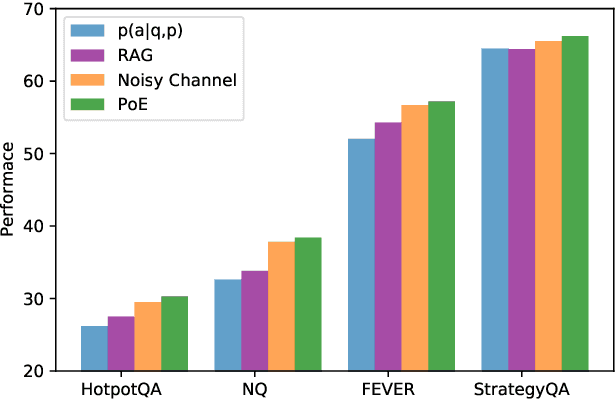
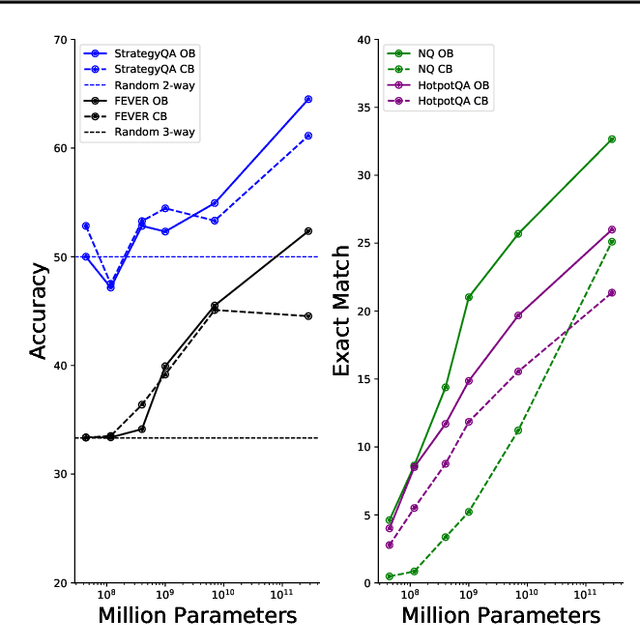
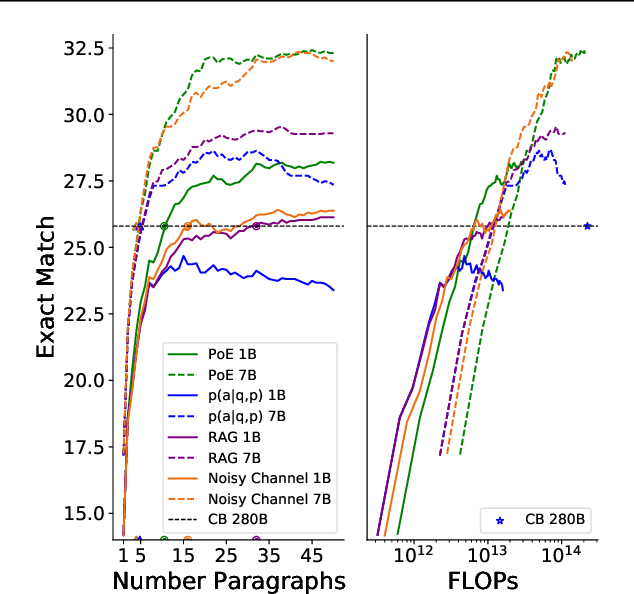
Abstract:In this work, we aim to capitalize on the unique few-shot capabilities offered by large-scale language models to overcome some of their challenges with respect to grounding to factual and up-to-date information. Motivated by semi-parametric language models, which ground their decisions in external retrieved evidence, we use few-shot prompting to learn to condition language models on information returned from the web using Google Search, a broad and constantly updated knowledge source. Our approach does not involve fine-tuning or learning additional parameters, thus making it applicable to any language model, offering like this a strong baseline. Indeed, we find that language models conditioned on the web surpass performance of closed-book models of similar, or even larger, model sizes in open-domain question answering. Finally, we find that increasing the inference-time compute of models, achieved via using multiple retrieved evidences to generate multiple answers followed by a reranking stage, alleviates generally decreased performance of smaller few-shot language models. All in all, our findings suggest that it might be beneficial to slow down the race towards the biggest model and instead shift the attention towards finding more effective ways to use models, including but not limited to better prompting or increasing inference-time compute.
Enabling arbitrary translation objectives with Adaptive Tree Search
Feb 23, 2022
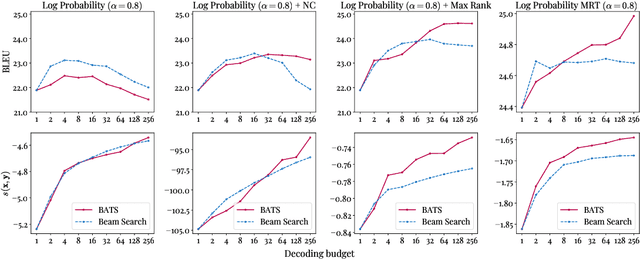

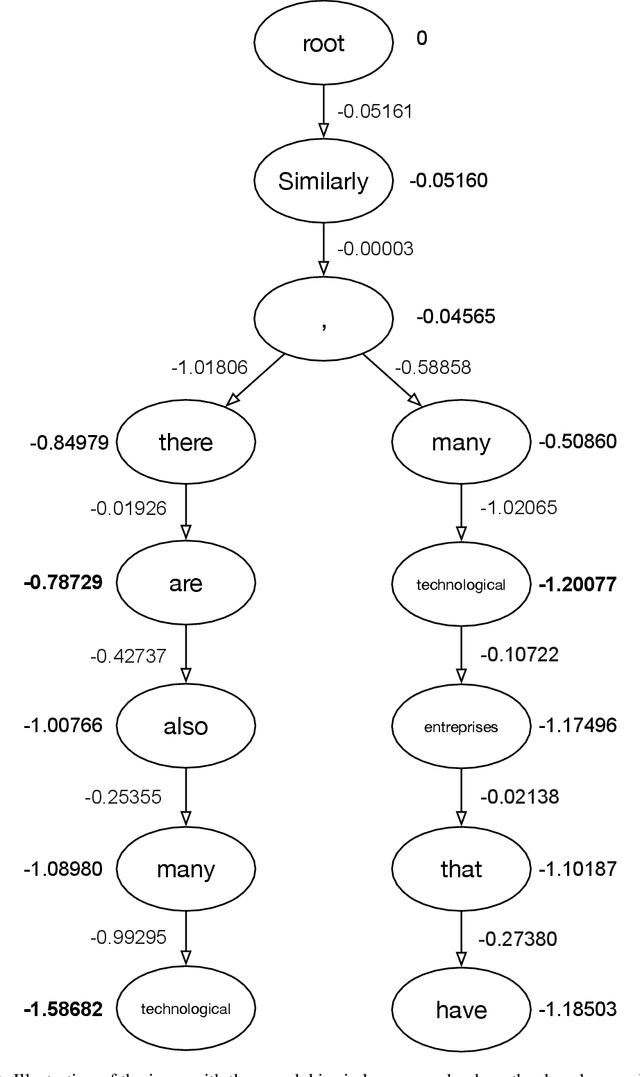
Abstract:We introduce an adaptive tree search algorithm, that can find high-scoring outputs under translation models that make no assumptions about the form or structure of the search objective. This algorithm -- a deterministic variant of Monte Carlo tree search -- enables the exploration of new kinds of models that are unencumbered by constraints imposed to make decoding tractable, such as autoregressivity or conditional independence assumptions. When applied to autoregressive models, our algorithm has different biases than beam search has, which enables a new analysis of the role of decoding bias in autoregressive models. Empirically, we show that our adaptive tree search algorithm finds outputs with substantially better model scores compared to beam search in autoregressive models, and compared to reranking techniques in models whose scores do not decompose additively with respect to the words in the output. We also characterise the correlation of several translation model objectives with respect to BLEU. We find that while some standard models are poorly calibrated and benefit from the beam search bias, other often more robust models (autoregressive models tuned to maximize expected automatic metric scores, the noisy channel model and a newly proposed objective) benefit from increasing amounts of search using our proposed decoder, whereas the beam search bias limits the improvements obtained from such objectives. Thus, we argue that as models improve, the improvements may be masked by over-reliance on beam search or reranking based methods.
Putting Machine Translation in Context with the Noisy Channel Model
Oct 01, 2019
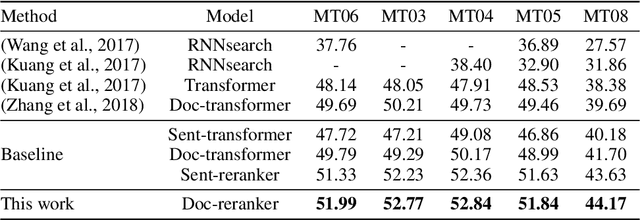
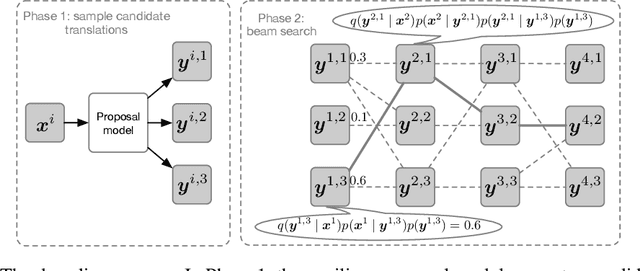

Abstract:We show that Bayes' rule provides a compelling mechanism for controlling unconditional document language models, using the long-standing challenge of effectively leveraging document context in machine translation. In our formulation, we estimate the probability of a candidate translation as the product of the unconditional probability of the candidate output document and the ``reverse translation probability'' of translating the candidate output back into the input source language document---the so-called ``noisy channel'' decomposition. A particular advantage of our model is that it requires only parallel sentences to train, rather than parallel documents, which are not always available. Using a new beam search reranking approximation to solve the decoding problem, we find that document language models outperform language models that assume independence between sentences, and that using either a document or sentence language model outperforms comparable models that directly estimate the translation probability. We obtain the best-published results on the NIST Chinese--English translation task, a standard task for evaluating document translation. Our model also outperforms the benchmark Transformer model by approximately 2.5 BLEU on the WMT19 Chinese--English translation task.
Adversarial Autoencoders for Generating 3D Point Clouds
Nov 19, 2018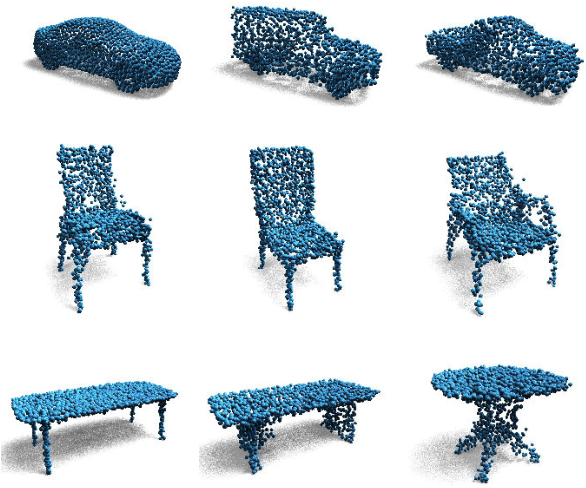
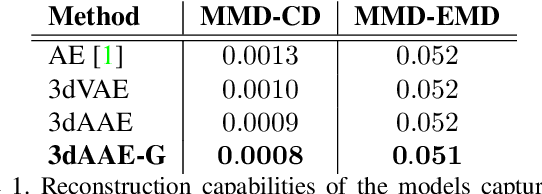
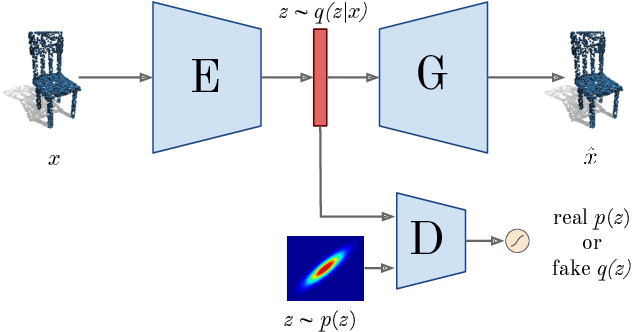

Abstract:Deep generative architectures provide a way to model not only images, but also complex, 3-dimensional objects, such as point clouds. In this work, we present a novel method to obtain meaningful representations of 3D shapes that can be used for clustering and reconstruction. Contrary to existing methods for 3D point cloud generation that train separate decoupled models for representation learning and generation, our approach is the first end-to-end solution that allows to simultaneously learn a latent space of representation and generate 3D shape out of it. To achieve this goal, we extend a deep Adversarial Autoencoder model (AAE) to accept 3D input and create 3D output. Thanks to our end-to-end training regime, the resulting method called 3D Adversarial Autoencoder (3dAAE) obtains either binary or continuous latent space that covers much wider portion of training data distribution, hence allowing smooth interpolation between the shapes. Finally, our extensive quantitative evaluation shows that 3dAAE provides state-of-the-art results on a set of benchmark tasks.
Fashion-Gen: The Generative Fashion Dataset and Challenge
Jul 30, 2018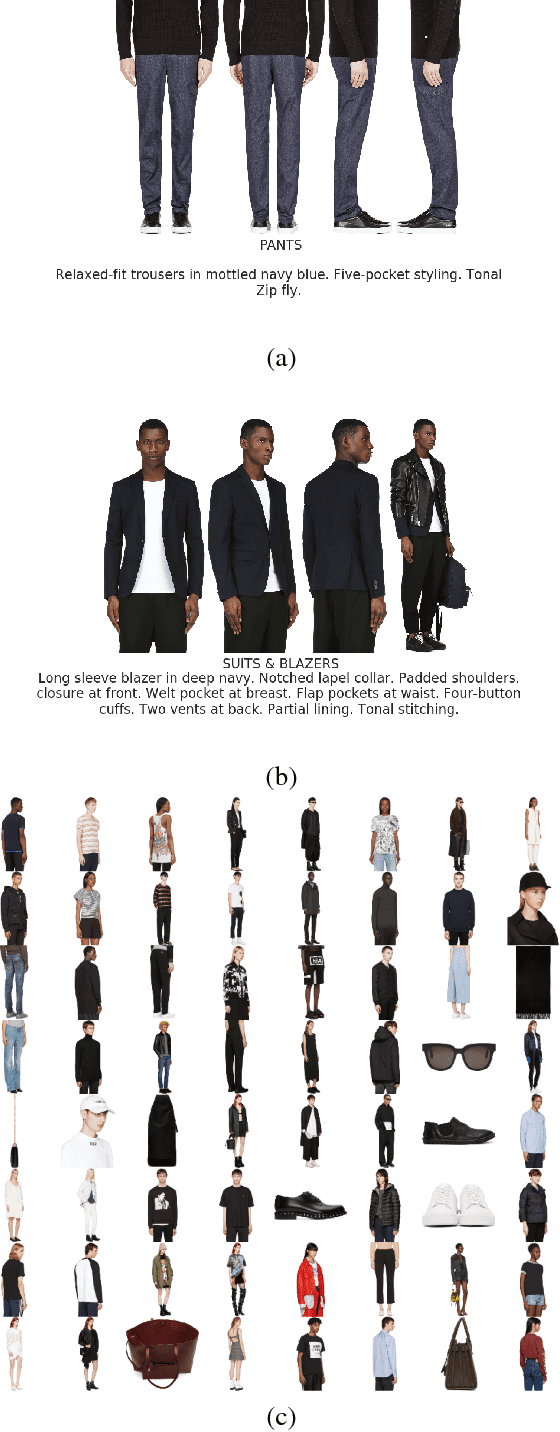

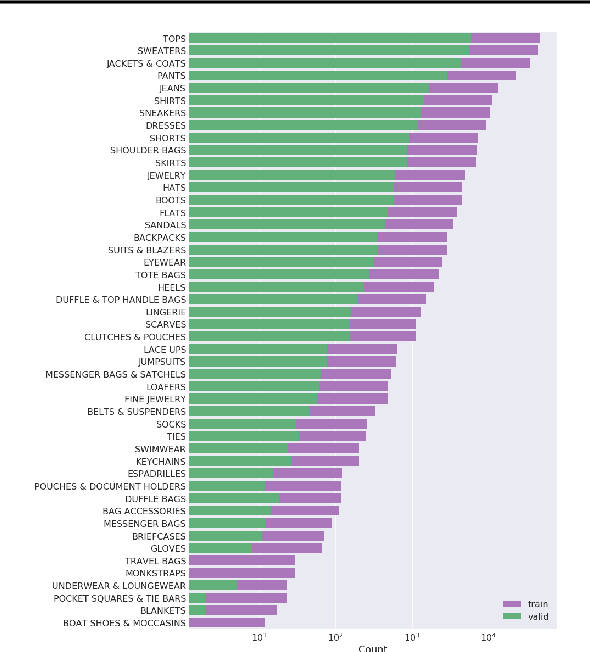

Abstract:We introduce a new dataset of 293,008 high definition (1360 x 1360 pixels) fashion images paired with item descriptions provided by professional stylists. Each item is photographed from a variety of angles. We provide baseline results on 1) high-resolution image generation, and 2) image generation conditioned on the given text descriptions. We invite the community to improve upon these baselines. In this paper, we also outline the details of a challenge that we are launching based upon this dataset.
What Looks Good with my Sofa: Multimodal Search Engine for Interior Design
Jan 08, 2018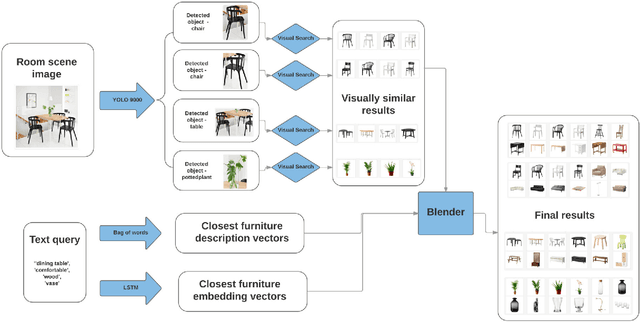
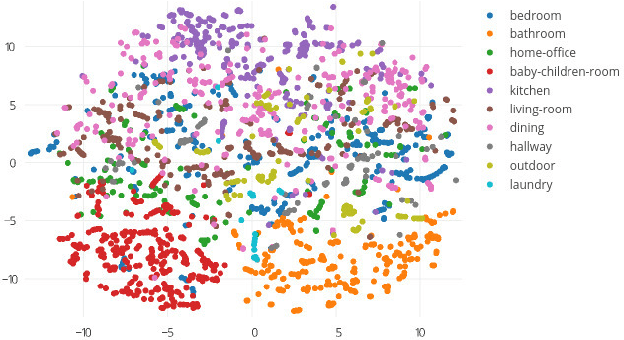
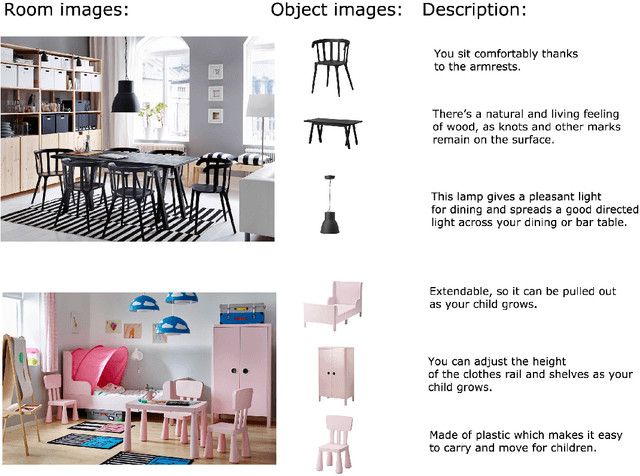
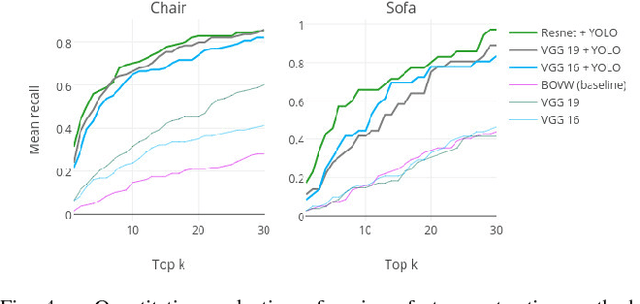
Abstract:In this paper, we propose a multi-modal search engine for interior design that combines visual and textual queries. The goal of our engine is to retrieve interior objects, e.g. furniture or wall clocks, that share visual and aesthetic similarities with the query. Our search engine allows the user to take a photo of a room and retrieve with a high recall a list of items identical or visually similar to those present in the photo. Additionally, it allows to return other items that aesthetically and stylistically fit well together. To achieve this goal, our system blends the results obtained using textual and visual modalities. Thanks to this blending strategy, we increase the average style similarity score of the retrieved items by 11%. Our work is implemented as a Web-based application and it is planned to be opened to the public.
* FEDCSIS 5th Conference on Multimedia, Interaction, Design and Innovation (MIDI), 2017
 Add to Chrome
Add to Chrome Add to Firefox
Add to Firefox Add to Edge
Add to Edge